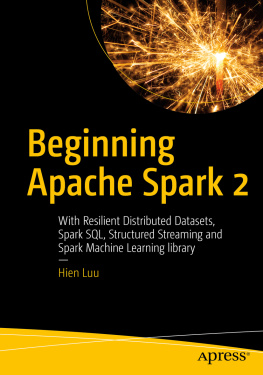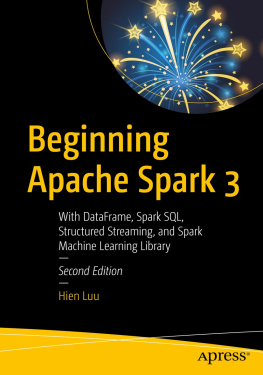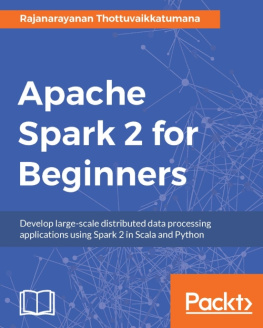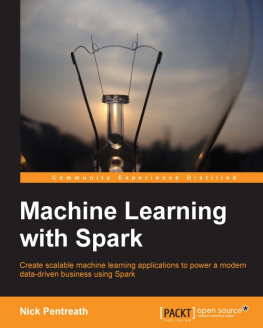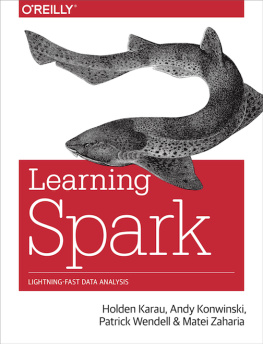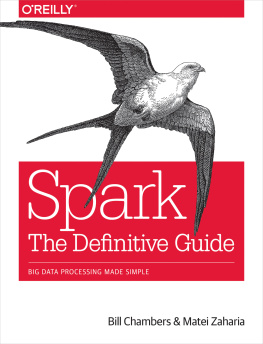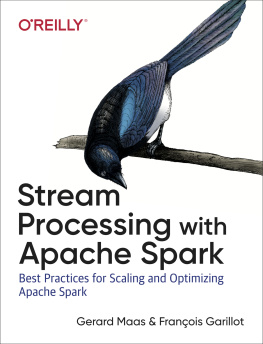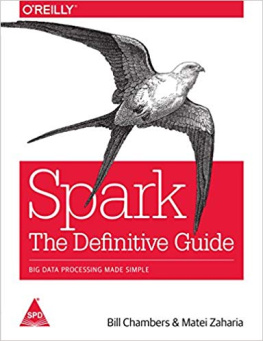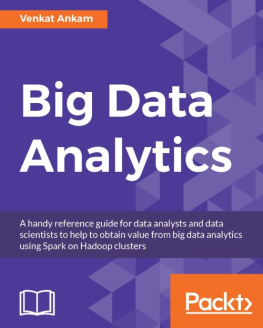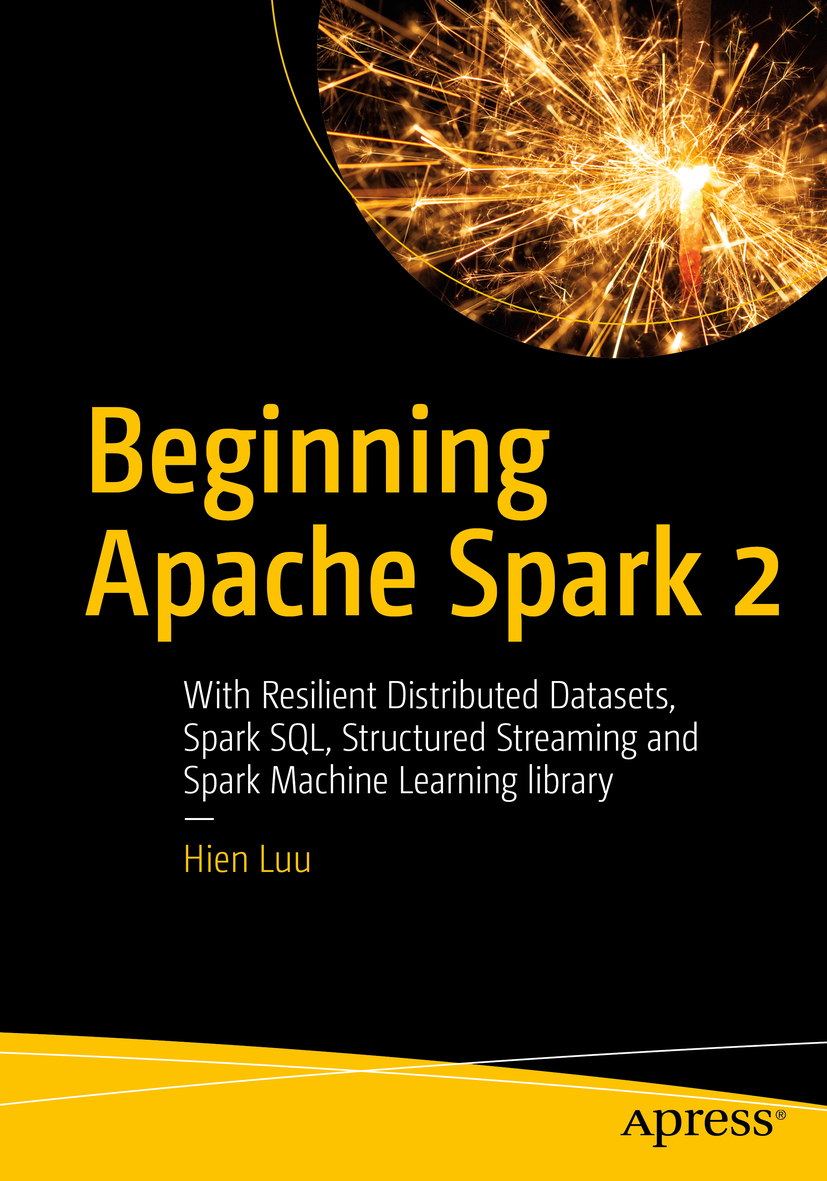Hien Luu
Beginning Apache Spark 2 With Resilient Distributed Datasets, Spark SQL, Structured Streaming and Spark Machine Learning library
Hien Luu
SAN JOSE, California, USA
Any source code or other supplementary material referenced by the author in this book is available to readers on GitHub via the books product page, located at www.apress.com/9781484235782 . For more detailed information, please visit www.apress.com/source-code .
ISBN 978-1-4842-3578-2 e-ISBN 978-1-4842-3579-9
https://doi.org/10.1007/978-1-4842-3579-9
Library of Congress Control Number: 2018953881
Hien Luu 2018
This work is subject to copyright. All rights are reserved by the Publisher, whether the whole or part of the material is concerned, specifically the rights of translation, reprinting, reuse of illustrations, recitation, broadcasting, reproduction on microfilms or in any other physical way, and transmission or information storage and retrieval, electronic adaptation, computer software, or by similar or dissimilar methodology now known or hereafter developed.
Trademarked names, logos, and images may appear in this book. Rather than use a trademark symbol with every occurrence of a trademarked name, logo, or image we use the names, logos, and images only in an editorial fashion and to the benefit of the trademark owner, with no intention of infringement of the trademark. The use in this publication of trade names, trademarks, service marks, and similar terms, even if they are not identified as such, is not to be taken as an expression of opinion as to whether or not they are subject to proprietary rights.
While the advice and information in this book are believed to be true and accurate at the date of publication, neither the authors nor the editors nor the publisher can accept any legal responsibility for any errors or omissions that may be made. The publisher makes no warranty, express or implied, with respect to the material contained herein.
Distributed to the book trade worldwide by Springer Science+Business Media New York, 233 Spring Street, 6th Floor, New York, NY 10013. Phone 1-800-SPRINGER, fax (201) 348-4505, e-mail orders-ny@springer-sbm.com, or visit www.springeronline.com. Apress Media, LLC is a California LLC and the sole member (owner) is Springer Science + Business Media Finance Inc (SSBM Finance Inc). SSBM Finance Inc is a Delaware corporation.
About the Author and About the Technical Reviewer
About the Author
Hien Luu
has extensive working experience in designing and building big data applications and scalable web-based applications. He is particularly passionate about the intersection between big data and machine learning. Hien enjoys working with open source software and has contributed to Apache Pig and Azkaban. Teaching is one of his passions, and he serves as an instructor at the UCSC Silicon Valley Extension school teaching Apache Spark. He has given presentations at various conferences such a QCon SF, QCon London, Seattle Data Day, Hadoop Summit, and JavaOne.
About the Technical Reviewer
Karpur Shukla
is a research fellow at the Centre for Mathematical Modeling at FLAME University in Pune, India. His current research interests focus on topological quantum computation, nonequilibrium and finite-temperature aspects of topological quantum field theories, and applications of quantum materials effects for reversible computing. He received an M.Sc. in physics from Carnegie Mellon University, with a background in theoretical analysis of materials for spintronics applications as well as Monte Carlo simulations for the renormalization group of finite-temperature spin lattice systems.
Hien Luu 2018
Hien Luu Beginning Apache Spark 2 https://doi.org/10.1007/978-1-4842-3579-9_1
1. Introduction to Apache Spark
Hien Luu
(1)
SAN JOSE, California, USA
There is no better time to learn Spark than now. Spark has become one of the critical components in the big data stack because of its ease of use, speed, and flexibility. This scalable data processing system is being widely adopted across many industries by many small and big companies, including Facebook, Microsoft, Netflix, and LinkedIn. This chapter provides a high-level overview of Spark, including the core concepts, the architecture, and the various components inside the Apache Spark stack.
Overview
Spark is a general distributed data processing engine built for speed, ease of use, and flexibility. The combination of these three properties is what makes Spark so popular and widely adopted in the industry.
The Apache Spark website claims it can run a certain data processing job up to 100 times faster than Hadoop MapReduce . In fact, in 2014, Spark won the Daytona GraySort contest, which is an industry benchmark for sorting 100TB of data (one trillion records). The submission from Databricks claimed Spark was able to sort 100TB of data three times faster and using ten times fewer resources than the previous world record set by Hadoop MapReduce.
Since the inception of the Spark project, the ease of use has been one of the main focuses of the Spark creators. It offers more than 80 high-level, commonly needed data processing operators to make it easy for developers, data scientists, and data analysts to build all kinds of interesting data applications. In addition, these operators are available in multiple languages, namely, Scala, Java, Python, and R. Software engineers, data scientists, and data analysts can pick and choose their favorite language to solve large-scale data processing problems with Spark.
In terms of flexibility, Spark offers a single unified data processing stack that can be used to solve multiple types of data processing workloads, including batch processing, interactive queries, iterative processing needed by machine learning algorithms, and real-time streaming processing to extract actionable insights at near real-time. Before the existence of Spark, each of these types of workload required a different solution and technology. Now companies can just leverage Spark for most of their data processing needs. Using a single technology stack will help with dramatically reducing the operational cost and resources.
A big data ecosystem consists of many pieces of technology including a distributed storage engine called HDFS, a cluster management system to efficiently manage a cluster of machines, and different file formats to store a large amount of data efficiently in binary and columnar format. Spark integrates really well with the big data ecosystem. This is another reason why Spark adoption has been growing at a really fast pace.
Another really cool thing about Spark is it is open source; therefore, anyone can download the source code to examine the code, to figure out how a certain feature was implemented, or to extend its functionalities. In some cases, it can dramatically help with reducing the time to debug problems.

